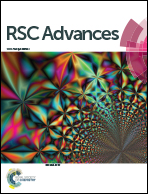RAFT-synthesized polymers based on new ferrocenyl methacrylates and electrochemical properties†
Abstract
Herein are reported the synthesis and the full characterization of three new ferrocenyl monomers, namely 2-(ferrocenylmethoxy)ethyl methacrylate (FMOEMA), 3-(ferrocenylmethoxy)propyl methacrylate (FMOPMA) and 4-(ferrocenylmethoxy)butyl methacrylate (FMOBMA), synthesized from ferrocenemethanol. Homopolymers were prepared by reversible addition–fragmentation chain transfer (RAFT) polymerization in toluene at 70 °C using 2-cyanoprop-2-yl-dithiobenzoate (CPDB) as a chain transfer agent. Polymerization kinetics were compared to those of the well-known 1-ferrocenylmethyl methacrylate (FMMA). The ferrocenyl containing monomers with alkoxy linkers were found to be as reactive as FMMA in RAFT polymerization. Polymers with controlled molar masses with dispersities lower than 1.5 were obtained. The chemical structures of the monomers and polymers were fully characterized by NMR and size exclusion chromatography. Glass transition temperatures of these methacrylic polymers ranged from 36 °C to 2 °C when controlling the length of the alkoxy linker between the ferrocene unit and the backbone. The electrochemical properties of the monomers and the homopolymers were demonstrated using cyclic voltammetry.


 Please wait while we load your content...
Please wait while we load your content...